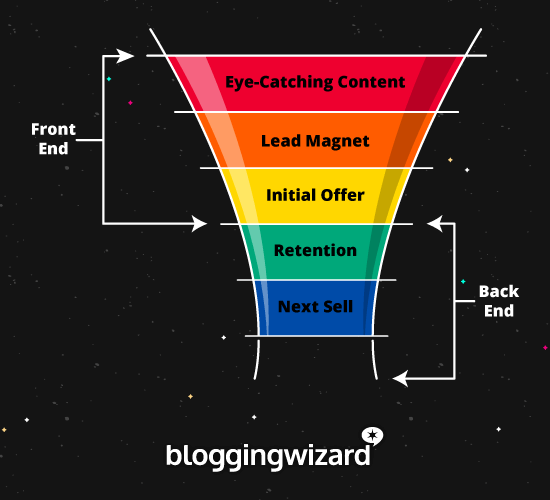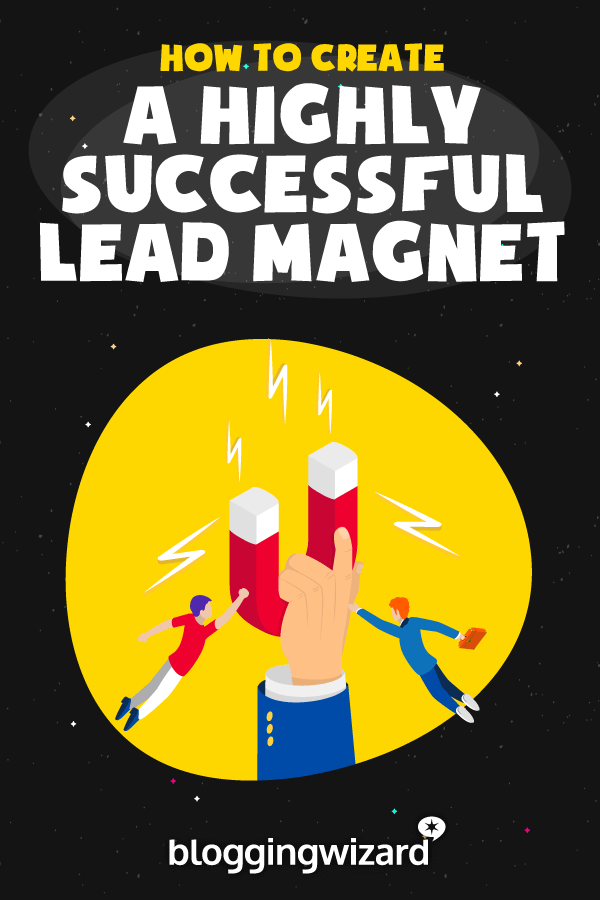How To Create A Lead Magnet That Converts Like Crazy

Want to accelerate the growth of your email list?
You’re going to need a lead magnet that converts.
In this post, you’re going to discover the ingredients of a successful lead magnet, how to decide on the right content type, and how to promote your lead magnet.
Ready? Let’s get started:
The ingredients of a successful lead magnet
In a moment we’ll talk about content types, but first, let’s talk about getting your actual lead magnet right.
What ingredients does it need? What do you need to think about before you start creating? Think of this part as laying your foundation.
Here’s exactly what your lead magnet needs to be:
Goal-driven
While your lead magnet needs to be something your audience will love, it’s also got to work for your business.
Even if you haven’t got a sales funnel mapped out – you need to start thinking about your product/service offering as a sales funnel.
What’s your high ticket offer? What will subscribers be offered after they get your lead magnet?
Whatever you offer next needs to be the next logical step in the customer journey. Everything has to flow from one end to the other.
In a nutshell, here’s how a basic sales funnel will look:

To get started, I recommend checking out this Blogging Wizard post on sales funnels. It’s a good primer to help you visualise how your sales funnel will work.
Solution-focused
Do you know what problems your audience is facing? If not, now is the time to define your target audience and create your first persona.
Avoid general “top-level” stuff here. It’s often the more specific problems that will set your lead magnet apart.
And if you’re not sure what challenges your audience is facing, you can just ask them. Create a survey using Typeform. Then send it out to your followers via email and social media.
If you need more, sift through Facebook groups, Quora, Reddit, and other communities. You may even find some insights in the comments of big blogs in your niche.
Useful
A lot of readers will subscribe before they buy any products from you. Your lead magnet gives them a taste of things to come.
Whatever you offer has to be useful enough that subscribers will value it and be happy they subscribed. On the other hand, it shouldn’t be so useful that it devalues your paid offering.
Easy to follow
When crafting the perfect lead magnet, readability and user experience are important.
Make sure everything is easy for your readers, so they can implement what they learn.
Brief
While this does somewhat depend on your chosen niche, it’s worth mentioning.
Generally, you’ll find that concise lead magnets perform best. An ebook clocking in at 300+ pages may be tremendous value for your audience, but will they use it?
Shorter lead magnets are more likely to be used. So, consider saving that in-depth ebook as a paid product for further down your sales funnel.
Finding the right content type for your lead magnet
There are plenty of lead magnet ideas out there, but which should you choose?
Below, I’ll share some of my favourite content types to help you decide.
Checklists
Checklists are process driven so they encourage people to take action, and they make it easy, too!
They’re straight forward to create and it’s highly likely that you can simply repurpose some of your blog posts into checklists without much hassle.
Templates
I’ve had some great success with templates in the past. For example, in the Blogging Wizard Resource Library, I offer subscribers a bunch of different templates.
This includes audience personas, competitor research, and even lead magnet templates. Like checklists, they’re easy to put together and they’re extremely useful.
Cheatsheets
Think of cheat sheets as the cliff notes of another piece of content. Simply take a detailed piece of content and distill the information down so it’s easier to digest.
Guides
Ebooks don’t convert as well as they used to, but shorter guides can still be effective – especially if they’re well formatted and optimized to encourage subscribers to take action.
Discount codes
Do you run an ecommerce site, or offer any sort of products? Offering discount codes can be a great incentive to build your email list.
Even if you don’t have your own products, you could still arrange deals with your partners and create an exclusive deals page. This could be bundled together with some other content types.
Viral quizzes
Quizzes can be super effective because of how much they get shared on social media.
And with the right tool, you can add an opt-in gate to build your email list.
If you use WordPress, there are plenty of great WordPress quiz plugins on the market to help you. Be sure to check out our tutorial on how to build a personality quiz with WordPress.
Social media contests
Like quizzes, social media contests can be a great way to encourage people to subscribe to your email list.
The great thing is that you don’t have to create much in the way of content for this to work. And you don’t even have to give anything away yourself – you can partner up with brands to donate products and discount codes.
To get started, check out our post on social media contests tools – these will make the process easy.
Important note: Always be upfront about what people are signing up for and consider GDPR compliance (I’m not a lawyer, so I can’t offer legal advice).
What do you need to promote your lead magnet?
Once you’ve created your lead magnet, how will you promote it? Let’s explore some of the options:
1. Setup compelling email sign up forms
Your blog posts will be one of the best ways to promote your lead magnet.
To do this, you just need to add a compelling email sign up form to your blog posts.
There are plenty of form types you can leverage:
- In-content forms
- Header/footer notification bars
- Slide-in forms
- Exit intent popovers
- After post opt-ins
On Blogging Wizard, I have multiple lead magnets. I have an exit intent popover that targets specific post categories, then I add in-content opt-in forms strategically.
For example, on our audience persona post, you’ll see this form I created with Thrive Leads:

These are technically considered “content upgrades,” but they’re really just post-specific lead magnets.
And don’t worry, you don’t necessarily need multiple lead magnets. In most cases one is enough.
For example, on Funnel Overload (now Startup Bonsai), I offer a single lead magnet and embed a CTA within blog posts. I used Thrive Leads for this too.

Quick note: Thrive Leads is a WordPress plugin. While there are a lot of email list building plugins for WordPress available, I prefer Thrive Leads because it offers split testing, API integrations with popular email service providers, and all the opt-in form types I need to grow my email list.
There are also a bunch of advanced list building techniques you can implement that I haven’t found in any other plugin.
Learn more in our Thrive Leads review or read our step-by-step tutorial.
2. Create a well-optimized landing page
First, let me explain what a landing page is:
A landing page can technically be any page that one of your visitors lands on, but in this context what we’re talking about is a landing page that is optimized for “campaign traffic.”
What this means is one page that is 100% focused on encouraging visitors to take a desired action. Specifically; joining your email list & downloading your lead magnet.
This means no navigation area, no sidebars, no distractions of any kind. Although you will need links to legal pages in your footer. And while they may be branded to fit with the design of your site, they are typically separate.
Now, why would you want to bother with a landing page?
Landing pages convert higher than any opt-in forms and they’re particularly well suited for driving traffic from ads, social media, YouTube videos, guest posts, etc.
You can create landing pages tailored to specific audience personas and optimize your messaging in a way that gives you a significant lift in conversions.
For example, this landing page I built for Funnel Overload (now Startup Bonsai) converts at over 30% and it’s not particularly well optimized (I built it in a rush and haven’t gotten round to split testing it yet).

So, how do you build a landing page? Depending on which content management system you use, you may be able to build landing pages out of the box. And some email marketing services like ConvertKit actually have the option built-in.
Otherwise, you’ll need a purpose-built landing page plugin. I typically use Leadpages for building landing pages & running split-tests, but it is a SaaS app so can get pricey.
If you use WordPress, Thrive Optimize is a great option. It’s part of the Thrive Suite which also includes Thrive Architect.
And split-testing is extremely important if you want to improve your conversions.
Why? Best practice is only the starting point. Not every industry, niche or audience group is the same so to get the biggest conversion gains, you need split-testing to discover what actually works.
You can learn more in my comparison of WordPress landing page plugins.
3. A promotional strategy
Once you’ve got your lead magnet, compelling sign up forms, and a well-optimized landing page – you’re going to need a promotional plan.
Your email sign up forms will offer your lead magnet to blog readers. So, your content strategy will take care of ensuring your email sign up forms get traction.
Although, I’d definitely recommend crafting some new posts that are topically relevant to your lead magnet, and adding some targeted opt-in forms. You could even add in-content opt-in forms to your high traffic posts (the more relevant, the better.)
So, what about your landing page?
Here are a few ways you can promote your lead magnet’s landing page:
- Add a link to your landing page within your author bio (on your blog.)
- Create vertical images in Canva and share them on Pinterest.
- Write guest posts and link to your landing page in your author bio.
- Share excerpts from your lead magnet on social media, with a link to your landing page.
- Update your social media bios with a link to your landing page.
- Run a paid ad campaign on Facebook (be careful running ads – you’ll need a product & well-optimized sales funnel to ensure you get a return on your investment.)
- Update your email signature with a link to your lead magnet.
- Add a “swipe up” link to your Instagram story (only available for verified accounts or those with over 10,000 followers.)
- Partner up with influencers and include them in your lead magnet in some way (chances are, they’ll share it, even though the content is gated.)
- Do a “lead magnet” exchange with other bloggers in a related niche.
- Add a call to action to your sidebar that links to your landing page.
There we go – that’s plenty of ideas to get you started!
Wrapping it up
We’ve looked at what you need to think about when planning your lead magnet, content types to consider, and what it takes to get people signing up to download your lead magnet.
Just be sure to remember that however you present your lead magnet, be clear about what they’re signing up for.
And step back from your lead magnet to view the flow of your entire sales funnel.
It’s your sales funnel that will drive revenue and send visitors from your free content through to your paid content.
Just to illustrate the power of sales funnels:
In the previous section I mentioned how you can write guest posts and link to your landing page in the author bio.
If you’ve got a sales funnel setup, you won’t just be getting subscribers, you’ll be getting customers. That’s how Daniel Ndukwu wrote a free guest post for Blogging Wizard and earned $1,800 in the process. Not bad, right?!

